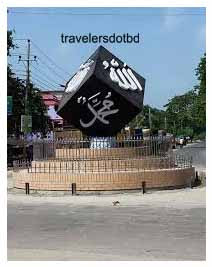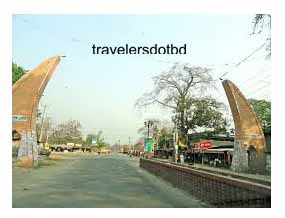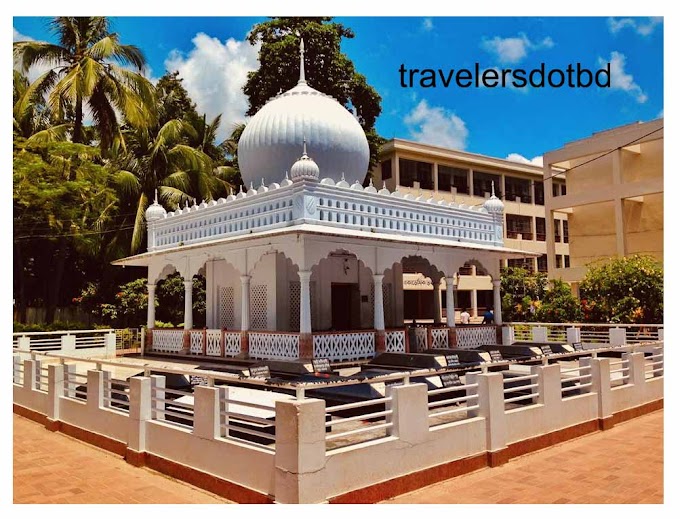Meherpur
Naming
So far we've known two conjectural facts about the naming of Meherpur. One is that the naming of Meherpur within the sixteenth century or later, keep with the name of an individual named Meher Ali, a preacher of Islam. Hazrat Khan Jahan Ali (R) started spreading Islam extensively in greater Kushtia, Jessore, Khulna, Barobazar, Chuadanga and Meherpur. Pir Khan Jahan Ali went from Gaur to Barobazar via Meherpur on the Bhairab river and visited Bagerhat. he's said to have had 360 saints and 70,000 soldiers with him at that point . He raised the banner of victory of Islam within the whole of the south and established settlements and regimes. At an equivalent time, variety of flag-bearers of Islam arrived within the region. The names of Shah Bhalai, Shah Alai and Enayet Ullah are noteworthy. The naming of Meherpur has been established keep with the name of Meher Ali Shah, the flag bearer of the holy soul Islam. As far as is understood , Meher Ali was documented as a really influential and famous spiritual person. The second aspect about the origin of naming Meherpur is that the famous Bachankar Mihir and his own daughter-in-law Khana (Khanar Bachan are famous) lived during this area on the banks of the river Bhairab. It's believed that Mihirpur was first named after him and later Meherpur in Apabhramsa.
History of Meherpur
Accurate information about the naming of Meherpur has been lost long before the golden pages of history. Assumptions, perceptions or analyzes are the sole alternatives during this regard without self-satisfaction. There has been tons of writing on this subject for an extended time but the topic remains a spectacle.
So far two conjectural facts are found about the naming of Meherpur. One is that the naming of Meherpur dates back to the sixteenth century or a while later, keep with the name of a person named Meher Ali, a preacher of Islam. Secondly, Bachankar Mihir and his daughter-in-law Khana are said to have lived in this city. The name Meherpur springs from the name Mihirpur after Meherpur.
In the 2nd century AD, a map of Mr. Ptolemy, a well known geographer, found several small islands within the Ganges basin. This small archipelago is taken into account to be Kushtia, Chuadanga, Meherpur region. It's going to be assumed that some people of Punda or Pod race from South Bengal or people of various religions from the encompassing area came and settled during this fertile island area rising from the Ganges or the other wetland.
By the top of the 2nd century and therefore the beginning of the 4th century, nothing significant was known about the Samatat of East Bengal and therefore the Puskaran kingdom in West Bengal , or any significant history of the region during the Gupta rule out the 5th century. During the rule of the three states of Samatat, Banga and Gaur in Bangladesh, the Meherpur region was once under the rule of Samatat and Gaur. However, historians haven't been ready to agree on the precise extent of those three kingdoms. it's not known exactly under which king Meherpur was under direct rule till the 6th century AD. The account given by Hiuen Tsang, a Chinese traveler who visited Bangladesh during the reign of King Shashanka in 606 A.D. Was divided into five parts. The Meherpur region is believed to have belonged to the dominion of King Shashankar within the seventh century.
There is also reason to take a position that Meherpur, 70 km from the capital of the Shashanka kingdom, was under his direct rule. After the death of Shashanka, the dominion of Gaur was torn apart by internal strife and conflict. After the death of King Shashanka, probably around 642, Meherpur became a part of the dominion of Kamrup Raj Bhaskar Burma. Extreme anarchy prevailed in Bengal for nearly 100 years after the death of Shashanka. At that point , the emperor maintained their rule out which region remained completely covered by Amanisha. At the time of the establishment of the Buddhist Pala dynasty in Bengal within the fifties of the eighth century, it's assumed that Meherpur was under the rule of the Pala dynasty and therefore the region belonged to the Pala dynasty till the top of the Pala dynasty, i.e. till the top of the tenth century.
During the reign of Lakshman Sen in 1203 AD, in 1204 AD, on the way from Bihar to Jharkhand, a Turkish Muslim infinitely brave general named Ikhtiyar Uddin Muhammad Bakhtiyar Khilji captured Nadia, the capital of Lakshman Sen, with only 16 cavalry. Of the massive army behind Bakhtiyar, only 18 cavalry were ready to come quickly with him. However, forty years after Bakhtiyar's conquest of Nadia, Minhaj-us-Siraj's Tabaqat-i-Nasiri mentions that when only eighteen cavalrymen entered the town of Nadia, they weren't stopped by anyone who considered them Turkish horse sellers. In fact, at that point Lakshman Sen, thanks to adulthood , neglected the monarchy, various conspiracies and corruption of the nobility and therefore the queen probably weakened the state structure. thanks to which Sen didn't have the power and courage to resist the Turkish attack.
Khilji attacked the palace as soon as he appeared. At that point , Roy Lachhmania was eating food at the top of all the work. When he received the news of the Muslim attack, he abandoned his son, wife, wealth, property, slaves and everything else and fled by boat through the gates of the center . Bakhtiyar Khilji captured Nadia and marched to Gaur. Although the conquest of Nadia by Bakhtiyar was considered because the beginning of Muslim rule out the region, Muslim rule wasn't ready to achieve any stability at that point . About fifty years after his conquest of Nadia, Murgis Uddin Uzbek recaptured Nadia. the start of the primary Muslim rule out Bengal at Nadia lasted for about 600 years.
The history of Muslim rule out the entire of Bengal evolved within the half of the thirteenth century after the autumn of the reign of Hindu Rajah Lakshman Sen, the last independent ruler of Bengal, and therefore the establishment of Muslim rule out his capital Nadia. From 1203 or 1204 to the civil gain of British Malay Archipelago Company in 185, a complete of 6 subadars, nazims, kings and nawabs ruled Bengal in 561 years. Meherpur belonged to all or any of them during their rule. Eleven of those rulers were nominated by the Subadar Ghori and Khilji Muslim Sultans, twenty-six of whom were independent rulers, including the rulers of the Sher Shah period. The remaining thirty-four were chosen by the Mughal emperors.
Among the five independent kings are Rajah Ganesh, Jalal Uddin (Jadu), Shamsuddin Ahmed Shah. Apart from these five and King Todarmal and King Mansingh, most were of Afghan, Turkish, Iranian and Mughal descent. During the reign of Gias Uddin Azam Shah, the king of Gaur, from 1389 to 1409, all types of kingdoms and administrations in Gaur were occupied by Rajah Kangs or Ganesha, the zamindar of Bhaturia Pargana, and established an independent state.
After the demise of Ganesha, his son Jadu, who took the Muslim name, continued to rule the throne of Md. Jalaluddin Gaur. After his death, his son Sultan Shamsuddin Ahmad Shah inherited the dominion . it had been from this point that the spread of Islam within the region began on an outsized scale. Nasiruddin Muhammad Shah of Ikhtiyar Shahi dynasty seized the throne of Gaur by brutally killing Shamsuddin Ahmad Shah. Meherpur is claimed to have been a really prosperous region during the Sultanate period. within the fourteenth century, variety of Auliya saints came here to spread Islam in Meherpur.
During the reign of Mughal Emperor Akbar, Bhavananda Majumdar (his childhood name Durgadash Samaddar) of Bagoan in Meherpur established an enormous dynasty. Which was established within the name of Nadia dynasty. the world during which the Nadia dynasty established the state by establishing zamindari came to be referred to as Nadia. At this point the zamindari area of Nadia State was 3,151 square miles. Bhabananda Majumdar, the founding father of the Nadia kingdom, was ready to attain the position of Kanungo because of the generosity of Shah Ismail, the ruler of Hughli. Later on, as a result of helping Mirza Nathan and Rajah Mansingh within the battle with Pratapaditya, he was ready to get the title of "Bhavananda Majumdar" from King Jahangir. His zamindari kingdom consisted of Lepa, Mahatpur, Marupadaha, Sultanpur, Kasimpur and Nadia with a complete of 14 parganas. Durgadas Samaddar gave his father's zamindari to his brother Jagadis Kurulgachhi, Haribalsnav to Fatehpur and Tubuddhi to Patik Bari.
He kept Vallabhipur Pargana in his charge. It's said that Rajah Raghab Roy of the Bhaband Majumdar dynasty was a worshiper of Krishna from Matiar. It's worth mentioning that Maharajah Rudra, the son of Rajah Raghab, named this place Krishnanagar. Later this Krishnanagar became the capital of Nadia district.
In 162, King Krishnachandra became the Gadinsin of Nadia. one among the areas of this Nadia was Meherpur and Meherpur has been ruled for an extended time under the rule of King Krishnachandra. Rajah Krishnachandra was unable to pay the customary rent of Nadia in due time and was arrested by Nawab Murshikuli Khan. It's known from the history of 1750 that Meherpur city was established within the sixteenth century but no settlement was established there at that point . Because, in 1750 it had been under the rule of Nawabs under Mughal rule.
In 1750, Alivardi Khan, the subedar of Bengal, wanted to come by river to the village of Bagoyan in Meherpur to hunt. As a result of the inclement weather, he was forced to simply accept the hospitality of the councilor, Raju Gonsai, an unknown widow, Gowala Ramni. it's said that Nawab Alivardi Khan was impressed by the hospitality and donated the whole Bagoyan mouza on the east bank of the river Bhairab to the lady . Raju Gosai woman had many cows. And for this reason he provided the entire area of Bagoyan i.e. Meherpur for grazing. It is often seen that Meherpur was a pasture even within the seventeenth century. Not many settlements are formed here.
Until the battle of Palashi on 23 June 1757, Rajah Goala Chowdhury built a road directly from Nadia Sadar Krishnanagar to Meherpur. the development of this road became a nightmare for Meherpur. Bargi bandits wont to attack Meherpur and loot huge wealth. so as to guard themselves from the oppression of the Bargis, the descendants of Goyala Chowdhury built secret shelters with bricks underground and dug trenches round the whole area. His remains were found therein underground shelter south of Meherpur municipality. Several large tamarind trees were within the area. the general public was warned of the attack of the Bargis from that tree. History testifies that Rajya Goyala Chowdhury was brutally killed during a battle with Raghuji Vosla, the infamous Bargi bandit leader.
The independence of Bengal came to an end in 1757 when Clive won British war with Sirajuddaullah at Amrakan in Palashi. Therein farce, King Krishnachandra of Nadia supported Clive, so Mr. Clive won the battle and awarded Krishnachandra the title of Rajendra Bahadur. In 175 the Malay Archipelago Company was ready to gain civil rights in Bengal, Bihar and Orissa. From this point Nadia or Meherpur came under the rule of British . Although the boundaries of Nadia and Jessore were demarcated in 1896, it had been changed several times later. Nadia i.e. Kushtia and Meherpur have an extended relationship with Jessore. Meherpur was established in 1854 or 1856 as a subdivision.
There were five subdivisions of undivided Nadia namely Krishnanagar, Ranaghat, Kushtia, Chuadanga and Meherpur. After its establishment as a subdivision, Meherpur included 5 thanas namely Karimpur, Gangni, Tehtra, Chapra and Meherpur Sadar. At the time of partition in 1947, Karimpur, Tehratra and Chapra were included in India, Meherpur subdivision was formed with only Gangni and Meherpur Sadar.
On 24 February 1984, Meherpur became a full-fledged district. On 24 February 2000, Meherpur Sadar Upazila was divided into Mujibnagar Upazila. At present Meherpur district has three upazilas.
Declaration of Independence
Declaration of official independence of Bangladesh on 17 April 1971 by the expatriate government of Bangladesh. During the war of liberation this declaration came into force as an interim constitution to control the expatriate Mujibnagar government. Even before the new constitution of independent Bangladesh was enacted on 16 December 1972, this declaration remained effective because of the constitution of the country. On 25 March 1971, on the eve of the Pakistani military offensive against the people of Dhaka and other parts of Bangladesh , senior Awami League leaders, members of theConstituent Assembly and Provincial Councils crossed the border into India for safety. By March 30, many of them had gathered in Calcutta. All the members of the Constituent Assembly and therefore the Provincial Council who met in Calcutta by 10 April formed an expatriate legislature and drafted the Declaration of Independence. On 18 April, M Yusuf Ali, a member of the Constituent Assembly, formally read out the Declaration of Independence at an easy ceremony at Baidyanathtala (now Mujibnagar) on the border of Meherpur district. Through this declaration the newly formed legislature declared the independence and sovereignty of Bangladesh. During this declaration the expatriate Mujibnagar government was considered legitimate and during this declaration it had been directed to determine a sequence of command among all the participants within the liberation war.
Places of interest





0 Comments